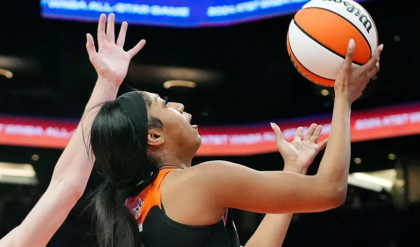The recent matchup between the Indiana Fever and the Washington Mystics has ignited discussions across the WNBA community, with Caitlin Clark and Angel Reese emerging as focal points of analysis amidst a flurry of media attention.
Caitlin Clark’s standout performance for the Fever showcased her potential as a transformative player in the league. Scoring an impressive 29 points, grabbing 13 rebounds, and dishing out 5 assists, Clark demonstrated her versatility and impact on the court.
Despite the Fever’s loss, her ability to consistently contribute at such a high level signals promise for the team’s future. Analysts and fans alike have taken note of Clark’s evolution in the WNBA, praising her strategic gameplay and skill development, which have not only elevated her team but also enhanced the league’s overall appeal and viewer engagement.

In a parallel storyline, Angel Reese’s performance has also drawn attention, particularly her late-game double-double. While Reese’s shooting percentages have faced criticism, her ability to excel under the basket and contribute significantly to her team’s efforts deserves recognition. This performance underscores the complexities of evaluating players fairly, especially rookies who are still adjusting to the demands of professional basketball.
Kennedy Carter’s recent standout performance for the Atlanta Dream against the Chicago Sky has added to the league’s narrative, highlighting the individual brilliance that fuels team dynamics and captivates audiences. Carter’s impact serves as a reminder of the WNBA’s depth of talent and the pivotal role that emerging stars play in shaping game outcomes and league perceptions.

Amidst these performances, there is a growing consensus on the need for balanced assessments of players’ contributions.
While statistics provide insights into player performance, they must be contextualized within the broader dynamics of team strategy, opponent quality, and individual player development over time. This approach ensures that rookies like Reese are evaluated with fairness and patience as they continue to grow and refine their skills at the professional level.
Looking ahead, both Clark and Reese represent a new wave of talent that is reshaping the WNBA landscape.
As they continue to evolve and make their mark on the league, their journeys serve as inspiration for aspiring athletes and underscore the WNBA’s role in advancing women’s sports globally.
In conclusion, Caitlin Clark and Angel Reese’s performances have sparked excitement and debate within the WNBA, highlighting their individual achievements and the broader implications for team dynamics and player development in professional basketball.
As the season progresses, their contributions will undoubtedly continue to shape the narrative of the league, reaffirming its status as a premier destination for elite women athletes.
News
I’M DONE WITH YOU! Harry Shocks With Rage As Meghan Pack All Her Bags And Leave Montecito At 7Am
Prince Harry and Meghan Markle’s recent argument in Montecito has ignited intense public and media scrutiny. Witnesses reported a heated exchange, with Meghan hastily packing her belongings and leaving at 2 a.m., while Harry was heard shouting, “I’m done with…
SHE ASKED ME TO DESTROY HER! Meg TERRIFIED As Anne Honours Queen Last WISH To Destroy Netflix Act
In her final days, Queen Elizabeth II made one last request of her only daughter, Princess Anne. The aging monarch was deeply concerned about the damage being done to the royal family’s reputation by Prince Harry and Meghan, the Duke…
THAT WASN’T ARCHIE! Arthur Edwards EXPOSES Meghan’s 4 Year Secret About Staged Photo Of Fake Archie
The Royal Baby Photo Call: A Storm of Controversy Brews The birth of Archie Mountbatten-Windsor, Prince Harry and Meghan Markle’s first child, was a momentous occasion, eagerly anticipated by the world. However, the public introduction of their newborn son at…
HOW DARE YOU! Kate REOPENS Meghan SLAPP!NG Case Of Princess Charlotte & Files LawSuit After CBS Talk
The simmering feud between the Sussexes and the Royal Family has erupted into a full-blown war, with the Palace launching a blistering counter-attack against Meghan Markle’s claims of being bullied. In a stunning reversal of the narrative, the Palace has…
TRAGIC EVENT! Meghan & Harry To SELL £11M Mansion As They Are Chased Out By Montecito Neighbors
The gates of the sprawling $11 million Montecito estate swung open as the black SUV sped out, leaving the luxurious property behind in a cloud of dust. Inside the vehicle, the driver’s knuckles were white as they gripped the steering…
Meghan Gets OFFENDED by Jane Pauley Questions about Her Kids On CBS Sunday Morning Interview.
Meghan Markle’s recent interview with Jane Pauley on CBS has reignited controversy, particularly due to her visibly uncomfortable reaction to questions about her children. This incident has sparked renewed debate about the legitimacy of her family, with speculation growing over…
End of content
No more pages to load











